
The Nelson Monument is a monument to Admiral Horatio Nelson, in Exchange Flags, Liverpool, England. It was designed by Matthew Cotes Wyatt and sculpted by Richard Westmacott. It stands to the north of the Town Hall and was unveiled in 1813.

The Nelson Monument is a monument to Admiral Horatio Nelson, in Exchange Flags, Liverpool, England. It was designed by Matthew Cotes Wyatt and sculpted by Richard Westmacott. It stands to the north of the Town Hall and was unveiled in 1813.
In 1805, Liverpool City Council resolved to commemorate Nelson's victory at the Battle of Trafalgar by erecting a monument and voted to pay £1,000 towards its design and construction. A public subscription fund was launched and within two months a total of £8,930 (equivalent to £770,000in 2021) [1] had been reached; this included £750 from the underwriters at Lloyd's and £500 from the West India Association. It was agreed that the monument should be located in a prominent site near the Exchange. A competition for its design was arranged, and this was won by Matthew Cotes Wyatt, son of James Wyatt, the contract being signed in 1809. Matthew Wyatt was relatively inexperienced, and was assisted by Richard Westmacott. [lower-alpha 1] The first stone was laid on 15 July 1812, and the monument was unveiled on 21 October 1813, the eighth anniversary of Nelson's death. In 1866 the monument was moved to its present site in Exchange Flags to allow for an extension to the Exchange Buildings, and the Westmorland stone base was replaced by one in granite. [2]
As part of the construction of a bunker under Exchange Flags to house Western Approaches Command, a ventilation shaft was constructed under the monument, allowing airflow into the bunker below. [4]
For the 2023 Eurovision song contest celebrations, the monument was surrounded by 2,500 sandbags as part of an art installation called 'Protect the Beats'. [5] This was to reflect statues in Ukraine which were covered up to protect them from damage during the Russian invasion.

The monument consists of a bronze statue on a stone base. Its overall height is 29 feet (8.8 m), and the circumference of the base is 95 feet 4 inches (29.1 m). The base consists of a drum-shaped pedestal in Westmorland marble 8 feet 10 inches (2.7 m) high, standing on a granite basement 6 feet (1.8 m) high. [lower-alpha 2] Seated around the pedestal are four statues depicting manacled prisoners sitting in poses of sadness; they represent Nelson's major victories, the battles of Cape St Vincent, the Nile, Copenhagen, and Trafalgar. Set into the drum between the statues are four bronze bas-reliefs depicting other naval actions in which Nelson was involved. Encircling the pedestal above the statues are swags of laurel hanging from behind lions' heads. Attached to rings in the lions' mouths are chains that descend to manacle the prisoners. At the top of the pedestal is a cornice with an inscription in metal letters reading ENGLAND EXPECTS EVERY MAN TO DO HIS DUTY . [2]
On top of the pedestal is a bronze group of figures 14 feet 2 inches (4.3 m) high, each figure being 7 feet (2.1 m) in height, and forming a roughly pyramidal structure. There are five figures surrounded by the drapes and poles of captured flags, with an anchor and a rope on the ground. An idealised nude representation of Nelson, his amputated right arm covered by part of a flag, stands with one foot on a cannon and the other on an enemy's corpse, holding upright a sword on which Victory is placing the last of four crowns. [lower-alpha 3] To the right of Nelson is the figure of Death reaching out to touch him. On the left of Nelson is a British seaman striding forward. Behind Nelson is the figure of Britannia holding a laurel wreath and Nelson's decorations. [2]
The monument was the first item of public sculpture to be erected in Liverpool, [6] [7] and is recorded in the National Heritage List for England as a designated Grade II* listed building. [6] Grade II* is the middle of the three grades of designation for listed buildings and is applied to "particularly important buildings of more than special interest". [8]
Notes
Citations

Nelson's Column is a monument in Trafalgar Square in the City of Westminster, Central London, built to commemorate Vice-Admiral Horatio Nelson's decisive victory at the Battle of Trafalgar over the combined French and Spanish navies, during which he lost his life, killed by a French sniper. The monument was constructed between 1840 and 1843 to a design by William Railton at a cost of £47,000. It is a column of the Corinthian order built from Dartmoor granite. The statue of Nelson was carved from Craigleith sandstone by sculptor Edward Hodges Baily. The four bronze lions around its base, designed by Sir Edwin Landseer, were added in 1867.
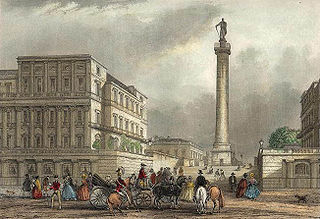
The Duke of York Column is a monument in London, England, to Prince Frederick, Duke of York, the second son of King George III. The designer was Benjamin Dean Wyatt. It is sited where a purposefully wide endpoint of Regent Street, known as Waterloo Place and Gardens, meets The Mall, between the two terraces of Carlton House Terrace and their tree-lined squares. The three very wide flights of steps down to The Mall adjoining are known as the Duke of York Steps. The column was completed in December 1832, and the statue of the Duke of York, by Sir Richard Westmacott, was raised on 10 April 1834.
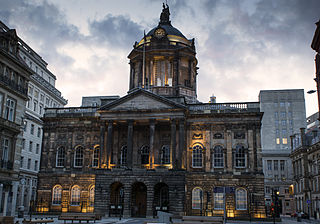
Liverpool Town Hall stands in High Street at its junction with Dale Street, Castle Street, and Water Street in Liverpool, Merseyside, England. It is recorded in the National Heritage List for England as a designated Grade I listed building, and described in the list as "one of the finest surviving 18th-century town halls". The authors of the Buildings of England series refer to its "magnificent scale", and consider it to be "probably the grandest ...suite of civic rooms in the country", and "an outstanding and complete example of late Georgian decoration".

St John's Gardens is an open space in Liverpool, England, to the west of St George's Hall. The gardens are part of the William Brown Street conservation area, and comprise one of the two open spaces within Liverpool's World Heritage Site. It has been a Green Flag site since 2003. The gardens contain ornamental flower beds, and memorials to notable people of the city.
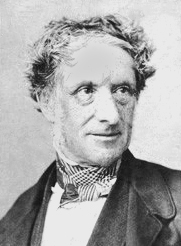
Sir Richard Westmacott was a British sculptor.

Wellington's Column, or the Waterloo Memorial, is a monument to the Duke of Wellington standing on the corner of William Brown Street and Lime Street, Liverpool, Merseyside, England. It is recorded in the National Heritage List for England as a designated Grade II* listed building.
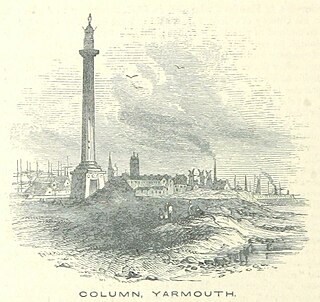
The Nelson's Monument is a commemorative column or tower built in memorial to Admiral Horatio Nelson, situated on the Denes, Great Yarmouth in the county of Norfolk, England. It was designated as a Grade I listed structure in 1953.
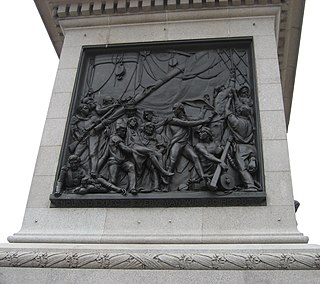
John Edward Carew was a notable Irish sculptor during the 19th century. His most prominent work is The Death of Nelson, one of the four bronze panels on the pedestal of Nelson's Column in Trafalgar Square.

The Statue of Horatio Nelson by Richard Westmacott, RA (1775–1856) stands in the Bull Ring, Birmingham, England.

Horatio Nelson, 1st Viscount Nelson (1758–1805) was a British flag officer in the Royal Navy famous for his participation in the Napoleonic Wars, most notably in the Battle of Trafalgar, during which he was killed. He was responsible for several famous victories that helped to secure British control of the seas, both securing Britain from French invasion and frustrating Napoleon's imperial ambitions. After his death during his defeat of the combined French and Spanish fleets at Trafalgar, there was a public outpouring of grief. Nelson was accorded a state funeral and was buried in St Paul's Cathedral.

Nelson's Column is a monument, designed by Scottish architect Robert Mitchell and erected in 1809 in Place Jacques-Cartier, Montreal, Quebec, Canada, which is dedicated to the memory of Admiral Horatio Nelson, following his death at the Battle of Trafalgar. Subsequent to the destruction of Nelson's Pillar in Dublin (1808–1966), Montreal's pillar now stands as the second-oldest "Nelson's Column" in the world, after the Nelson Monument in Glasgow. It is also the city's oldest monument and is the oldest war monument in Canada.

The Statue of Queen Victoria stands on the western side of Victoria Square, St Helens, Merseyside, England. It was created after the death of Queen Victoria and given to the town by Colonel William Windle Pilkington, mayor of St Helens in 1902, and a member of the Pilkington glass manufacturers in the town. Pilkington commissioned George Frampton to design it. Frampton used the same model for the figure of the queen for two other statues, but placed it on thrones and pedestals of different designs. The St Helens statue was unveiled by the Earl of Derby in 1905. Originally placed in the centre of Victoria Square, it was moved to a position on the west side of the square in 2000. The statue is recorded in the National Heritage List for England as a designated Grade II* listed building.

A bronze statue of Charles James Napier by the sculptor George Gammon Adams stands in Trafalgar Square in London, United Kingdom. It occupies one of the four plinths in Trafalgar Square, the one to the southwest of Nelson's Column.

The Nelson Monument located within Glasgow Green is a commemorative obelisk built in honour of Vice Admiral Horatio Nelson, who had died at the Battle of Trafalgar on 21 October 1805. Funds of £2,075 were raised by subscription, and the foundation stone of the monument was laid with full ceremony on 1 August 1806, on the anniversary of the battle of Aboukir. The monument was finished on 7 August 1807, believed to be the first completed in the UK. It was decorated with four flags, a large crowd watched, and ships at the Broomielaw had their flags hoisted all day. A decision had not then been made on intended inscriptions.

Exchange Flags is a Grade II listed building in Liverpool, England. It is laid out in a 'U' shape, with Walker House situated on the west side and Horton House on the east side. Walker House was adapted during its construction to include a reinforced bunker that housed the Western Approaches Command Headquarters, the command centre for the campaign waged against the German submarine fleet during the Second World War. The courtyard faces Liverpool Town Hall and contains the Nelson Monument.

The statue of Charles James Fox stands at the north end of Bloomsbury Square in the London borough of Camden. Erected in 1816, the sculptor was Richard Westmacott. It commemorates the Whig politician who died in 1806. Fox is shown in the garb of a Roman senator. The statue is a Grade II* listed structure.

A bronze statue of General Charles George Gordon by Hamo Thornycroft stands on a stone plinth in the Victoria Embankment Gardens in London. It has been Grade II listed since 1970. A similar statue stands at Gordon Reserve, near Parliament House in Melbourne, Australia, on its original tall plinth.

A bronze statue of British naval officer Horatio Nelson, 1st Viscount Nelson was installed at National Heroes Square in Bridgetown, Barbados from 1813 to 2020. It has since been relocated to the Barbados Museum.

The Edward VII Memorial, commonly known as the Peace Statue or Peace Memorial, is a statue on the boundary of Brighton and Hove on the English south coast. The monument was built in 1912 and sculpted by Newbury Abbot Trent.